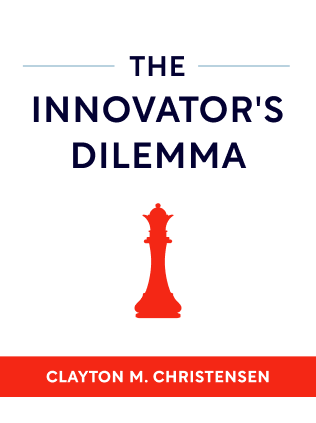

This article is an excerpt from the Shortform summary of "The Innovator's Dilemma" by Clayton M. Christensen. Shortform has the world's best summaries of books you should be reading.
Like this article? Sign up for a free trial here .
What are value network examples? How do value networks fit into the context of the Seagate case study?
The Seagate case study is about the company’s choices in addressing disruptive disk drives. Looking at value network examples, Seagate technology developed a response.
Read on to understand the value network examples in the Seagate case study.
Seagate Case Study and Value Network Examples
Let’s look at how the 5.25-inch drive innovator Seagate’s value network examples influenced the company’s decision-making as it confronted the emergence of disruptive 3.5-inch disk drives. The development and spread of the disruptive technology breaks down into six steps:
Step 1: Established Firms Develop the Technology
Established companies often develop disruptive technologies first—though the projects are typically initiated by engineers, not company leaders—and entrants are simply at the forefront of bringing the technology to market.
Example: Seagate was actually among the first firms in the industry to develop 3.5-inch drives, although it wasn’t one of the first to market the drives. Seagate’s engineers had made dozens of prototypes of the 3.5-inch drives by the time company managers finally approved the project. When they got approval, the engineers showed their prototypes to the firm’s marketing team. These prototypes included value network examples.
Step 2: Firms Gauge Customer Interest
When established firms consider developing a disruptive product, they gauge the existing market’s interest in the new technology. By definition, disruptions aren’t attractive to established customers, and the customers’ negative response typically dissuades companies from proceeding.
In some cases, executives allow disruptive projects to continue past this stage—but a lack of conviction about the product’s potential undercuts the commitment to the project. As a result, in day-to-day situations, time and resources are diverted to other projects.
Example: Seagate’s marketers showed the drives to customers, who weren’t interested in them because the low-capacity drives didn’t meet their needs. Based on customers’ feedback, the marketing team created dreary sales forecasts, and company leaders killed the project.
Step 3: Established Firms Double-Down on Sustaining Innovations
Based on customer input, established firms’ marketing teams not only discourage executives from pursuing disruptive technologies, but they also push for increased effort on sustaining technology to improve existing products.
Example: Seagate compared the market forecasts for 5.25-inch and 3.5-inch drives. The 5.25-inch models with 60-100 MB capacities were projected to bring in 35-40 percent gross profit margins. On the other hand, the 3.5-inch drives had an unknown profit projection—plus, the company’s existing 20 MB-capacity drives brought merely 25-30 percent gross margins. Using these comparisons, Seagate upped production of new-and-improved 5.25-inch models.
Step 4: Startups Form and Find Customers
After leadership at established firms turn away from disruptive projects, frustrated engineers often join entrant firms in pursuing the new technology. The startups face the same struggle as established firms in using the disruptive technology to attract customers in the existing market—but, unlike established firms, the entrants have no other products to fall back on, so they’re forced to find a market. Through trial and error, the startups eventually find the emerging markets for their innovations.
Example: Unhappy with managers’ strategies, employees from Seagate and Miniscribe—the two biggest 5.25-inch drive producers—left the established firms to found Conner Peripherals, which ultimately led the industry in 3.5-inch drives. Conner knew that desktop computer makers wouldn’t buy the 3.5-inch drives, so it hit upon the laptop market. The outlook for the laptop market was unclear, but the company had no choice but to try it.
Step 5: Disruptive Products Invade the Established Market
The disruptive technology’s performance improvement progresses up the S-curve until it reaches a level of sophistication that appeals to the customers that previously rejected it. In addition to dominating in the emerging market, the new technology then invades the old technology’s market.
Example: The capacity improvements for the 3.5-inch drives outpaced what the laptop market needed, and the small drive soon satisfied desktop makers’ needs. With the capacity increase, the 3.5-inch drive’s small size, lower price, and reliability made it more attractive to personal computer makers than the 5.25-inch drives.
Step 6: Established Firms Try to Catch Up
Once the startups begin invading the old technology’s market, established firms make an effort to defend their territory and revive the projects they’d killed in Step 3. However, the established firms discover that the entrants have a competitive advantage.
Since the entrants developed their disruptive products in a lower value network (the emerging market), they created cost structures that made the product profitable at lower gross margins. The entrants bring their lower cost structures to the established market, which allows them to offer lower prices than the established firms, whose organizations are built around higher cost structures.
Example: When Conner Peripherals began selling its 3.5-inch drives to desktop computer makers, Seagate Technology dusted off its 3.5-inch prototypes. Since Seagate had waited until the disruptive 3.5-inch drives invaded the desktop industry before producing its own models, the company simply sold the smaller drives to its existing customers—cannibalizing its own 5.25-inch sales. Seagate Technology never expanded into the laptop market. This was a poor utilization and analysis of their value network examples.
Outcome of Flash Memory Innovation
The value network examples best predicted established companies’ trajectories in response to flash memory.
Disk drive makers hit a limit on how much they could lower the production cost per drive. Since low-capacity disk drives had the same cost floor as high-capacity drives, disk drive makers focused on producing high-capacity drives (around a gigabyte or more), which better served its customers.
This left an opening for flash memory cards to fill the void in the emerging 10-40 megabyte market. Industry experts predicted that a 40 MB flash card and 40 MB disk drive would be around the same price by the time the book was published in 1997.
(Shortform note: Flash memory eventually improved enough to invade an established market and replace hard disks in laptops. Flash-based solid-state drives (SSDs) are now in top-performing laptops, including the MacBook Pro and Microsoft Surface.
Although the Seagate case study ends with the company withdrawing its flash products from the market, the company made a wise decision in retaining a stake in SunDisk—in fact, it’s a strategy we’ll talk more about in Part 2. SunDisk was eventually renamed SanDisk, and the company is now one of the top eight vendors in the memory card market worldwide.)

———End of Preview———
Like what you just read? Read the rest of the world's best summary of Clayton M. Christensen's "The Innovator's Dilemma" at Shortform .
Here's what you'll find in our full The Innovator's Dilemma summary :
- Christensen's famous theory of disruptive innovation
- Why incumbent companies often ignore the disruptive threat, then move too slowly once the threat becomes obvious
- How you can disrupt entire industries yourself






